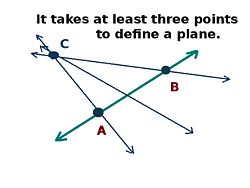Plane (geometry)
Please create the "Talk page". Just click this Talk page link and save the page.

Non-axiomatic approach
Definitions
A remark
To define a plane is more complicated than it may seem.
It is tempting to define a plane as a surface with zero curvature (or something like that). However, this is not a good idea, since the notions of surface and curvature are much more complicated than the notion of plane. In fact, several different notions of surface are introduced by topology and differential geometry, and several different notions of curvature are introduced by differential geometry; these are far beyond elementary mathematics. Fortunately, it is possible to define a plane via more elementary notions, and this way is preferred in mathematics. Still, the definitions given below are tentative. They are criticized afterwards, see "axiomatic approach".
Definitions of plane given below may be compared with the definition of circle as consisting of those points in a plane that are a given distance (the radius) away from a given point (the center). A circle is a set of points chosen according to their relation to some given parameters (center and radius). Similarly, a plane is a set of points chosen according to their relation to some given objects (points, lines etc). However, a circle determines its center and radius uniquely; for a plane, the situation is different.
Four equivalent definitions of plane are given below. Any other definition is equally acceptable provided that it is equivalent to these. Note that a part of a plane is not a plane. Likewise, a line segment is not a line.
Below, all points, lines and planes are situated in the space (assumed to be a three-dimensional Euclidean space), and by lines we mean straight lines.
Definition via distances
Let two different points A and B be given. The set of all points C that are equally far from A and B (that is, ) is a plane.
This is the plane orthogonal to the line AB through the middle point of the line segment AB.
Definition via right angles (orthogonality)
Let two different points A and B be given. The set of all points C such that the lines AB and AC are orthogonal (that is, the angle BAC is right) is a plane.
This is the plane orthogonal to the line AB through the point A.
Definition via lines
Let three points A, B and C be given, not lying on a line. Consider the lines DE for all points D on the line AB different from B and all points E on the line BC different from B. The union of all these lines, together with the point B, is a plane.
This is the plane through A, B and C.
In other words, this plane is the set of all points F such that either F coincides with B or there exists a line through F that intersects both the line AB and the line BC, and not at their intersection point B.
Definition via cartesian coordinates
In terms of cartesian coordinates x, y, z ascribed to every point of the space, a plane is the set of points whose coordinates satisfy the linear equation . Here real numbers a, b, c and d are parameters such that at least one of a, b, c does not vanish.
Some properties of planes
Most basic properties
For every three points not situated in the same straight line there exists one and only one plane that contains these three points.
If two points of a straight line lie in a plane, then every point of the line lies in the plane.
If two planes have a common point then they have at least a second point in common.
Every plane contains at least three points not lying in the same straight line, and the space contains at least four points not lying in a plane.
Further properties
Two planes either do not intersect (are parallel), or intersect in a line, or coincide.
A line either do not intersect a plane (is parallel to it), or intersects it at a single point, or is contained in the plane.
Two lines perpendicular to the same plane are parallel to each other (or coincide).
Two planes perpendicular to the same line are parallel to each other (or coincide).
Axiomatic approach
What is wrong with the definitions given above?
The definitions given above assume implicitly that the 3-dimensional Euclidean space is already defined, together with (at least one of) such notions as distances, angles, straight lines, Cartesian coordinates, while planes are not defined yet. However, this situation never appears in mathematics.
In the axiomatic approach points, lines and planes are undefined primitives.
The modern approach (see below) defines planes in a completely different way.
How does it work
Axiomatic approach is similar to chess in the following aspect.
A chess piece, say a rook, cannot be defined before the whole chess game is defined, since such a phrase as "the rook moves horizontally or vertically, forward or back, through any number of unoccupied squares" makes no sense unless it is already known that "chess is played on a square board of eight rows and eight columns" etc. And conversely, the whole chess game cannot be defined before each piece is defined; the properties of the rook are an indispensable part of the rules of the game. No chess without rooks, no rooks outside chess! One must introduce the game, its pieces and their properties in a singe combined definition.
Likewise, Euclidean space, its points, lines, planes and their properties are introduces in a set of 20 assumptions known as Hilbert's axioms of Euclidean geometry. The "most basic properties of planes" listed above are roughly the plane-related assumptions (Hilbert's axioms), while "further properties" are first plane-related consequences (theorems).
Modern approach
The modern approach defines the three-dimensional Euclidean space more algebraically, via linear spaces and quadratic forms, namely, as an affine space whose difference space is a three-dimensional inner product space. See space (mathematics) for further details.
In this approach a plane is defined as a two-dimensional affine subspace.
Plane figure
A plane figure is a combination of points and/or lines that fall on the same plane.
Rectilinear figure
A rectilinear figure is a plane figure consisting of straight lines only. Rectilinear figures include triangles and polygons.


